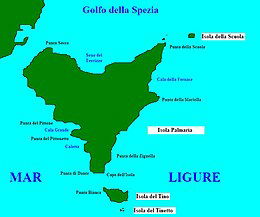PALMARIA


Palmaria Island, with its surface of 1.89 km², is the largest of the three islands in the Gulf of La Spezia and in the entire Ligurian territory; the other two islands, Tino and Tinetto, meet going down a few hundred meters in a straight line to the south.
The island has a triangular shape: the sides facing Porto Venere and the Gulf of La Spezia are the most anthropized and gently slope down to sea level, covered with typical Mediterranean vegetation.
The side of the island facing west, towards the open sea, is characterized by high cliffs overlooking the water, in which there are many caves: the Blue Grotto, which can be visited by boat, and the Grotta dei Colombi , which can only be reached by abseiling with ropes. This last cave in particular proved to be very important in the study of the historical events of the Gulf, as fossil bones of Pleistocene animals were found inside it, such as the chamois and the snowy owl, but above all the remains of human burials, which attest the presence of man at least five thousand years ago.
On the island there are also many buildings of a military nature and of great historical interest: on the top, inaccessible as a former military territory and currently in a state of neglect, the Conte di Cavour fort (or Fort Palmaria), the experimental battery now used as a environmental education center and battery Semaphore; at Punta Scuola, the armored tower Umberto I - which was equipped with two 400 mm Krupp guns, that is, with the highest caliber for the time -, used as a military prison after World War II and recently renovated and the remains of the Albini battery; scattered throughout the island, several bunkers dating back to the Second World War and the remains of coastal and anti-aircraft artillery positions mostly inaccessible as they are abandoned and invaded by vegetation.
Worthy of note, in the southern part of the island called Pozzale, the quarry now abandoned and once used for the extraction of the precious black marble with golden streaks called portoro. There are still the remains of the cranes and hoists used to move the marble blocks, as well as the walls of the miners' homes.
The island has a triangular shape: the sides facing Porto Venere and the Gulf of La Spezia are the most anthropized and gently slope down to sea level, covered with typical Mediterranean vegetation.
The side of the island facing west, towards the open sea, is characterized by high cliffs overlooking the water, in which there are many caves: the Blue Grotto, which can be visited by boat, and the Grotta dei Colombi , which can only be reached by abseiling with ropes. This last cave in particular proved to be very important in the study of the historical events of the Gulf, as fossil bones of Pleistocene animals were found inside it, such as the chamois and the snowy owl, but above all the remains of human burials, which attest the presence of man at least five thousand years ago.
On the island there are also many buildings of a military nature and of great historical interest: on the top, inaccessible as a former military territory and currently in a state of neglect, the Conte di Cavour fort (or Fort Palmaria), the experimental battery now used as a environmental education center and battery Semaphore; at Punta Scuola, the armored tower Umberto I - which was equipped with two 400 mm Krupp guns, that is, with the highest caliber for the time -, used as a military prison after World War II and recently renovated and the remains of the Albini battery; scattered throughout the island, several bunkers dating back to the Second World War and the remains of coastal and anti-aircraft artillery positions mostly inaccessible as they are abandoned and invaded by vegetation.
Worthy of note, in the southern part of the island called Pozzale, the quarry now abandoned and once used for the extraction of the precious black marble with golden streaks called portoro. There are still the remains of the cranes and hoists used to move the marble blocks, as well as the walls of the miners' homes.


